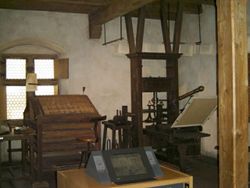Printing: Difference between revisions
m (Text replacement - "{{Page-ok|09/20}}" to "") |
No edit summary |
||
| Line 4: | Line 4: | ||
'''Printing''' is reproducing copies of [[text]] and/or [[image]]s (e.g. [[book]]s, newspapers, [[magazine]]s) by applying [[ink]] to [[paper]], as for publication. | '''Printing''' is reproducing copies of [[text]] and/or [[image]]s (e.g. [[book]]s, newspapers, [[magazine]]s) by applying [[ink]] to [[paper]], as for publication. | ||
Industrial printing is usually done with big printing presses. For [[home]] use and small quantities, a computer printer is used instead, such as a laser or | Industrial printing is usually done with big printing presses. For [[home]] use and small quantities, a computer printer is used instead, such as a laser or inkjet printer. | ||
== Printing techniques == | == Printing techniques == | ||
| Line 10: | Line 10: | ||
There are many different techniques for printing, such as: | There are many different techniques for printing, such as: | ||
* offset printing: today most books and newspapers are printed using this technique | * offset printing: today most books and newspapers are printed using this technique | ||
* relief print: mainly used for | * relief print: mainly used for catalogs | ||
* flexography: used for packaging, labels, and newspapers | * flexography: used for packaging, labels, and newspapers | ||
* screen printing: used for non-paper materials such as T-shirts or floor tiles | * screen printing: used for non-paper materials such as T-shirts or floor tiles | ||
| Line 24: | Line 24: | ||
== Printing in color == | == Printing in color == | ||
Printing in color presented a challenge during the early centuries. Early solutions were to create several plates, one for each color, which would be applied to the paper in several printing steps. However this resulted only in images that had two, three, four etc. distinct colors - but intermediate colors like those a [[painter]] | Printing in color presented a challenge during the early centuries. Early solutions were to create several plates, one for each color, which would be applied to the paper in several printing steps. However this resulted only in images that had two, three, four, etc. distinct colors - but intermediate colors like those a [[painter]] | ||
can mix on his palette (so-called '' | can mix on his palette (so-called ''halftones'' in printing) were hard to achieve. | ||
Today, the technique of [[screening]] allows to create the appearance of half-tone colors by printing the ink in tiny dots, rather than solid areas (see also [[tint]]ing). In most cases today the [[CMYK]] model is used for color printing, which uses four inks: cyan, magenta, yellow and black. Whenever special colors are required that are not part of the CMYK color space, or reflective, such as silver or | Today, the technique of [[screening]] allows to create the appearance of half-tone colors by printing the ink in tiny dots, rather than solid areas (see also [[tint]]ing). In most cases today the [[CMYK]] model is used for color printing, which uses four inks: cyan, magenta, yellow and black. Whenever special colors are required that are not part of the CMYK color space, or reflective, such as silver or | ||
Latest revision as of 17:36, 8 July 2021
Printing is reproducing copies of text and/or images (e.g. books, newspapers, magazines) by applying ink to paper, as for publication.
Industrial printing is usually done with big printing presses. For home use and small quantities, a computer printer is used instead, such as a laser or inkjet printer.
Printing techniques
There are many different techniques for printing, such as:
- offset printing: today most books and newspapers are printed using this technique
- relief print: mainly used for catalogs
- flexography: used for packaging, labels, and newspapers
- screen printing: used for non-paper materials such as T-shirts or floor tiles
- rotogravure: mainly used for magazines and packaging
- xerography (photocopy): used for fanzines and similar purposes
Historically, the following printing techniques were very important and mostly used to print artistic images such as book illustrations:
Printing in color
Printing in color presented a challenge during the early centuries. Early solutions were to create several plates, one for each color, which would be applied to the paper in several printing steps. However this resulted only in images that had two, three, four, etc. distinct colors - but intermediate colors like those a painter can mix on his palette (so-called halftones in printing) were hard to achieve.
Today, the technique of screening allows to create the appearance of half-tone colors by printing the ink in tiny dots, rather than solid areas (see also tinting). In most cases today the CMYK model is used for color printing, which uses four inks: cyan, magenta, yellow and black. Whenever special colors are required that are not part of the CMYK color space, or reflective, such as silver or gold, these are printed using additional special inks.
Chat rooms • What links here • Copyright info • Contact information • Category:Root
